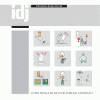
Pervasive and perplexing pies : Our evolving relationship with a data display genre
Although pie charts remain a highly popular genre for visualizing data, evident partly by their continued use in corporate annual reports, designers and theorists and have long critiqued and even denigrated them. This conflicted relationship with pie charts has resulted largely from their paucity of data, labeling difficulties, and perceptual weaknesses. Like many primary data design genres, however, pie charts attained their conventional status as a result of a long evolutionary process, initiated in the later nineteenth century by experimentation, hybrid forms, and data-rich designs. After the subsequent simplification and minimizing effects of twentieth-century modernism, pie charts have begun to experience a reemergence of innovation with digital data design, which has reintroduced hybridity into pie charts, vastly enlarged their data domain, and addressed at least some of their perceived weaknesses.
Keywords: annual reports; charts and graphs; data visualization; pie charts; visual rhetoric
Document Type: Research Article
Publication date: 31 December 2019
- Access Key
- Free content
- Partial Free content
- New content
- Open access content
- Partial Open access content
- Subscribed content
- Partial Subscribed content
- Free trial content